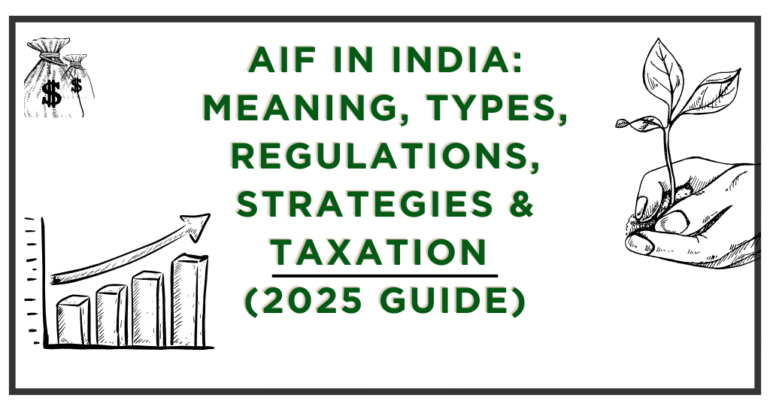
Alternative Investment Funds (AIFs) in India: Meaning, Types, Regulations, Strategies & Taxation (2025 Guide)
Introduction: What Are Alternative Investment Funds (AIFs)?
An Alternative Investment Fund (AIF) is a privately pooled vehicle that collects capital from accredited investors, HNIs, and institutions to invest in non-traditional assets such as private equity, venture capital, hedge funds, debt, or real estate.
SEBI introduced AIF regulations in 2012, bringing transparency, registration norms, and investor protections. Since then, AIFs have grown into the preferred vehicle for sophisticated investors seeking diversification beyond public markets.
AIF Structures & Legal Framework
- AIFs can be structured as a trust, LLP, company, or body corporate (trust is most common).
- Governed by the SEBI (AIF) Regulations, 2012.
- 2024–25 regulatory updates:
- Sunset clause: Maximum fund tenure capped at 10 years (with extensions in special cases).
- Large value AIF rules: New reporting and disclosure frameworks for funds >₹10,000 crore.
- VCC framework in GIFT City: Moving towards globally competitive structures.
Categories & Types of AIFs
SEBI divides AIFs into three broad categories, each with different strategies and risk-return profiles:
Category I AIFs:
- Focus: Venture capital, SME funds, social ventures, infrastructure.
- Growth-aligned sectors with regulatory incentives.
- Examples: Early-stage VC funds, renewable infrastructure funds.
Category II AIFs:
- Focus: Private equity, real estate, debt funds.
- No leverage allowed (other than temporary for operational needs).
- Examples: Growth-stage PE funds, structured credit, real estate development funds.
Category III AIFs:
- Focus: Hedge funds, derivatives, public market strategies.
- Can use leverage and complex trading.
- May be open- or closed-ended.
- Examples: Long-short equity funds, arbitrage funds, quant funds.
Types and Categories of Alternative Investment Funds (AIFs) in India
AIF Taxation: Category I, II, III Overview
AIF taxation in India depends on the fund category, investor type (resident/NRI), and nature of returns.
Category I & II:
- Pass-through status → gains taxed in the investor’s hands.
- STCG and LTCG as per direct equity/debt rules.
Category III:
- No pass-through → income taxed at fund level.
- Business income at 42.744% (including surcharge/cess).
- Capital gains as per asset rules (equity STCG/LTCG).
2025 update:
- Enhanced reporting requirements for AIFs and investors.
- NRIs investing via AIFs must comply with FEMA, FATCA, CRS reporting.
Comprehensive AIF Taxation Guide for 2025
AIF Minimum Investment (2025)
- ₹1 crore: Standard minimum investment across Category I, II, III.
- ₹25 lakh: Lower ticket size for angel funds and AIF employees/directors/managers.
- Ensures alignment with the long-term, illiquid, high-risk profile of AIFs.
- Designed for HNIs, UHNIs, and institutions, not retail investors.
Guide to the Exact AIF Minimum Investment in India
AIF vs PMS: Understanding the Difference
AIFs differ from PMS (Portfolio Management Services) primarily by regulatory scope, minimum investment, permitted asset classes, and investor profiles:
| Feature | AIF | PMS |
| Regulation | SEBI AIF Regulations | SEBI PMS Regulations |
| Minimum Investment | ₹1 crore | ₹50 lakh |
| Asset Flexibility | Broad: unlisted equity, debt, real estate, derivatives | Primarily listed equity + select debt/unlisted |
| Liquidity | Lower; lock-ins common | Moderate; no formal lock-in but exit loads may apply |
| Ownership | Fund-level (investor holds units) | Direct securities in demat |
| Investor Type | HNIs/Accredited | HNIs |
Detailed Comparison: PMS vs. Alternative Investment Fund
How to Invest in AIFs: Steps, Risks & Returns
- Check eligibility: Accredited investor / HNI with minimum capital.
- Select category & strategy: VC, PE, debt, hedge, etc.
- Review manager track record: Governance, past performance, strategy fit.
- Complete KYC & documentation: AIF agreement, subscription agreement.
- Fund commitment: Minimum ₹1 crore; commitment is typically drawn down over time.
- Stay updated: Monitor performance and regulatory filings.
Step by Step Guide on How to Invest in AIFs in India
Asset Classes, Strategies, and Benefits
Strategies & Assets
- Private equity & venture capital – startups, SMEs, growth capital.
- Real estate – development, yield platforms.
- Private debt & credit – mezzanine financing, distressed assets.
- Hedge & quant strategies – long-short, arbitrage, derivatives.
Benefits
- Diversification beyond listed equities/bonds.
- Access to high-growth, illiquid opportunities.
- Potential for superior IRRs vs. traditional funds.
- Hedge against public market volatility.
2025 trends:
- Over ₹13.49 trillion AUM; commitments doubled in three years.
- Real estate, IT/ITes, and financial services dominate allocations.
Performance and Top AIFs in India
Top-performing AIF funds and strategies:
- Real Estate: ₹69,896 crore net investments
- IT/ITes: ₹34,553 crore
- Financial Services: ₹27,223 crore
- NBFCs and Banks also in top sectors
- 110 out of 123 monitored AIF strategies produced gains by April 2025.
Regulatory Developments (2025 Update)
- Cap: Regulated entities cannot invest more than 20% of AIF corpus per scheme.
- Transparency: Stricter disclosure norms for large-value AIFs.
- Global alignment: Push for Variable Capital Companies (VCCs) in GIFT City.
- Sunset clause: Fund tenure capped at 10 years, improving investor visibility.
Why Aequitas Alternative Investment Funds (AIFs)
At Aequitas, our Category III long-only equity AIFs are built for HNIs seeking outsized returns from India’s small-cap universe:
- Focused strategy: High-potential small-cap businesses poised to be tomorrow’s leaders.
- Performance: 3-year CAGR of 27%, 5-year CAGR of 38% (as of Aug 2025).
- Expertise: SEBI-registered team with deep research pedigree.
- Risk management: Strong governance, forensic diligence, cycle-tested frameworks.
- Recognition: Ranked among top-performing Category III AIFs in India.
Check for the most consistently top performing AIF in India

